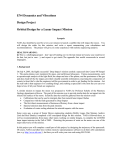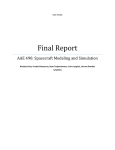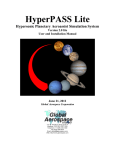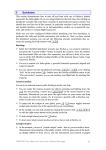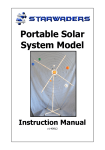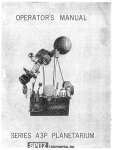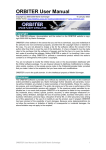Download ORBITER User Manual
Transcript
Appendix C Calculation of orbital elements Six scalar parameters (“elements”) are required to define the shape of an elliptic orbit, its orientation in space and a location along its trajectory. a Semi-major axis e Eccentricity i Inclination Longitude of ascending node argument of periapsis true anomaly C.1 Calculating elements from state vectors Let r and v be the cartesian position and velocity vectors of an orbiting object in coordinates of a reference frame with respect to which the elements of the orbit are to be calculated (e.g. geocentric equatorial for an orbit around Earth, or heliocentric ecliptic for an orbit around the Sun). We assume a right-handed system with the x-axis pointing towards the vernal equinox (or other reference direction) and the z-axis pointing upwards. Compute the following auxiliary vectors: h r v (ry vz n z h ( hy , hx ,0) e 1 v2 |r| rz v y , rx vz rz vx , rx v y ry vx ) r (r v) v where h is a vector perpendicular to the orbital plane, n points towards the ascending node (the z-component of n is zero), and e is the eccentricity vector (pointing towards the periapsis) with GM , G is the gravitational constant and M is the mass of the central body (neglecting the mass of the orbiter). Semi-major axis: a 2E with E v2 2 |r| Eccentricity: e | e | or e 1 2 Eh 2 2 Inclination: i arccos hz |h| Longitude of ascending node: arccos nx (if n y 0 then |n| 2 ) ORBITER User Manual (c) 2000-2010 Martin Schweiger 131 is the angle between reference direction (1,0,0) (e.g. vernal equinox) and the ascending node. is undefined for equatorial orbits (i = 0), in which case Orbiter by convention sets = 0, i.e. it places the ascending node in the reference direction, which is equivalent to setting n | n | (1,0,0) . Argument of periapsis: arccos n e (if ez 0 then | n || e | ) 2 is the angle between the ascending node and the periapsis. is undefined for equatorial orbits in which case according to above convention we get arccos ex (if ez 0 then |e| ) 2 is also undefined for circular orbits in which case Orbiter by convention places the periapsis at the ascending node, i.e. = 0. True anomaly: arccos e r (if r v 0 then | e || r | 2 ) is the angle between the periapsis and object position. Note that this expression is undefined for circular orbits, in which case the periapsis coincides with the ascending node according to the convention above, i.e. arccos n r (if n v 0 then | n || r | 2 ) If in addition the inclination is zero then the true anomaly further simplifies to arccos rx (if vx 0 then |r| 2 ) Some dependent parameters can be derived from the above elements: Linear eccentricity: =ae Semi-minor axis: b2 a 2 (1 e 2 ) Periapsis and apoapsis distances: dp a(1 e) da a(1 e) Longitude of the periapsis: Eccentric anomaly: E arccos 1 |r| a e Mean anomaly: ORBITER User Manual (c) 2000-2010 Martin Schweiger 132 M E e sin E Mean longitude: L M True longitude: l Orbit period: T 2 a3 ORBITER User Manual (c) 2000-2010 Martin Schweiger 133 Appendix D Terms of Use The ORBITER software, documentation and the content on the ORBITER website is copyright 2000-2010 by Martin Schweiger. ORBITER is not in the public domain: it is the intellectual property of Martin Schweiger. D.1 Orbiter Freeware License The licensor of Orbiter grants you a limited non-exclusive license to use, copy and distribute Orbiter, downloadable from orbit.medphys.ucl.ac.uk, without fee for personal, educational, charity and other non-commercial use. You agree to comply with the following conditions: You will not modify any of the binary codes of the Orbiter software in any way. If you publish a library module for Orbiter that uses undocumented features of the orbiter programming interface, or links to the orbiter core in an undocumented way, you must state this in the documentation for the module, and advise users of potential incompatibility of the module with future Orbiter versions. You will not sell Orbiter or any parts of it, or charge others for use of it (either for profit or merely to recover your media and distribution costs) whether as a standalone product, as part of a compilation or anthology, or included in a separate software package, without explicit prior written permission by the licensor. You will not remove or alter any copyright or license notices contained in the software and documentation, or remove or alter any identifying elements, including splash screens and logos, or try to hide or reassign in any way the name or origin of the software or any of its components. You will not use Orbiter or any parts of it to advertise, promote, present or sell any software or other product or service without explicit prior written permission by the licensor. You will not use Orbiter to engage in or allow others to engage in any illegal activity. D.2 Disclaimer of warranty THIS SOFTWARE IS PROVIDED BY THE AUTHOR AND CONTRIBUTORS 'AS IS' AND ANY EXPRESS OR IMPLIED WARRANTIES, INCLUDING, BUT NOT LIMITED TO, THE IMPLIED WARRANTIES OF MERCHANTABILITY AND FITNESS FOR A PARTICULAR PURPOSE ARE DISCLAIMED. IN NO EVENT SHALL THE AUTHOR OR CONTRIBUTORS BE LIABLE FOR ANY DIRECT, INDIRECT, INCIDENTAL, SPECIAL, EXEMPLARY, OR CONSEQUENTIAL DAMAGES (INCLUDING, BUT NOT LIMITED TO, PROCUREMENT OF SUBSTITUTE GOODS OR SERVICES; LOSS OF USE, DATA, OR PROFITS; OR BUSINESS INTERRUPTION) HOWEVER CAUSED AND ON ANY THEORY OF LIABILITY, WHETHER IN CONTRACT, STRICT LIABILITY, OR TORT (INCLUDING NEGLIGENCE OR OTHER- ORBITER User Manual (c) 2000-2010 Martin Schweiger 134 WISE) ARISING IN ANY WAY OUT OF THE USE OF THIS SOFTWARE, EVEN IF ADVISED OF THE POSSIBILITY OF SUCH DAMAGE. ORBITER User Manual (c) 2000-2010 Martin Schweiger 135






